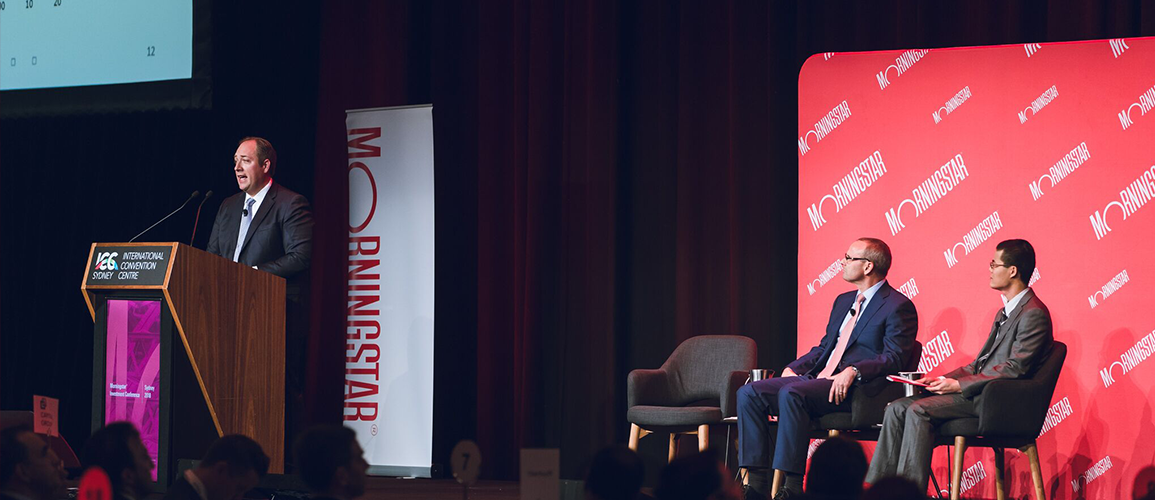Brad Boyd, Senior Vice President at Payden & Rygel and Brett Lewthwaite, Co-Head of Fixed Income at Macquarie Investment Management, shared their thoughts on the global fixed income market at the Morningstar Investment Conference 2018.
Impending economic and financial risks was the starting point to the debated question: Where can value be found in fixed income and what role can it play in a portfolio? The pair both felt we are heading into a period of uneasiness but had different opinions as to the root cause of tension, and hence the safeguards to employ. Boyd pointed to rising interest rates and inflation, and diminished diversification as reasons for investors to get creative with their fixed income exposure and consider assets other than long duration government bonds. He was particularly forthright in calling out government bond index funds, stating "this old umbrella won’t work." By contrast, Lewthwaite signalled the need for protection against risky assets (equity and corporate debt) which are carrying lofty valuations, so recommended loading up on duration and government bonds. These views symbolise Payden & Rygel's palette for a wide variety of credit opportunities relative to Macquarie's highly conservative investment approach.
From Where Will Risk Emerge?
It is safe to say the sentiment expressed in this discussion wasn’t as calamitous as that exhibited by the key note speaker. Franklin Templeton’s Michael Hasenstab predicted a perfect storm in global financial markets, including hurricanes caused by rising interest rates and the unwinding of the U.S. Federal Reserve’s balance sheet. Both Boyd and Lewthwaite agreed the historically high indebtedness of countries will exacerbate the impacts of rising interest rates, with Lewthwaite voicing it as “…debt and rising interest rates are not natural dancing partners.” But the pair were less concerned about the impact of the unwinding of the Fed’s bond portfolio. The magnitude of the Fed’s presence in bond purchases was unlike any other regime, reaching USD 4.5 trillion. But when asked where the shortfall in purchases is going to come from when the Fed doesn't show up, the panellists claimed the unwind won’t be dramatic. The Fed is ultimately constrained with how fast they can raise interest rates, and thus it won’t incur such a dire effect. Lewthwaite took this further and argued this scepticism is already baked into fixed income security prices, illuminating a contrarian positioning in this space. Risk assets, he said, will be where the pain is felt, as this is where valuations are stretched (corporate debt and other growth assets, particularly equities).
The conversation then turned to inflation. Wage inflationary pressures, Boyd argued have been driven by falling U.S. unemployment, and that this will negatively impact bonds. While Lewthwaite was also cautious on rising inflation, he was less concerned than his fellow panellist. He argued that outside of the U.S. experience (which dominates the world view) inflationary pressures are yet to be felt, and it’s questionable whether there indeed will be an inflation breakout like most are predicting. He believes demographics and digitalisation will “snuff it out,” and so the impact to traditional long duration government bonds is not as damaging.
The Role of Fixed Income in a Portfolio
So, with this impending backdrop in mind, what role can fixed income play in a portfolio? Boyd disputed the continual reliance on fixed income as a diversification tool. He argued the negative correlations between bonds and equities has only been relevant in the last 30 years. Prior to that the relationship was positive. If, Boyd submitted, the reason for falling equity markets this time is rising interest rates and rising inflation, then a positive correlation is likely—and that’s positive correlation with negative returns. He advocated a reduction in high duration government bonds, and a move toward floating rate exposure. Further, he stressed diversification within fixed income portfolios by including high-quality corporate credit. His message was clearly to avoid government bond index strategies.
It was no surprise Lewthwaite called for an increase in long duration government bonds, increasing portfolio defensiveness to counter the risks facing equities and spread assets. While still invested in investment-grade corporate credit, he argued now is not the time to hunt aggressively for yield at this late stage of the business cycle.
The panel hosted two experienced and time-tested portfolio managers, but also showcased the difficulties of investing in today's world. While there was some disagreement with what path to take when investing in bonds, what is clear is that the strong tail-wind that has propelled fixed income returns looks to be over and investors should expect more volatility in returns. As a result, it pays to be diversified and not solely exposed to one area when investing in bonds.





